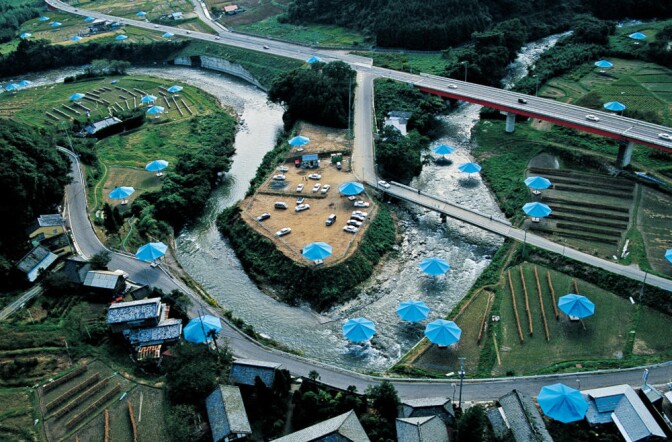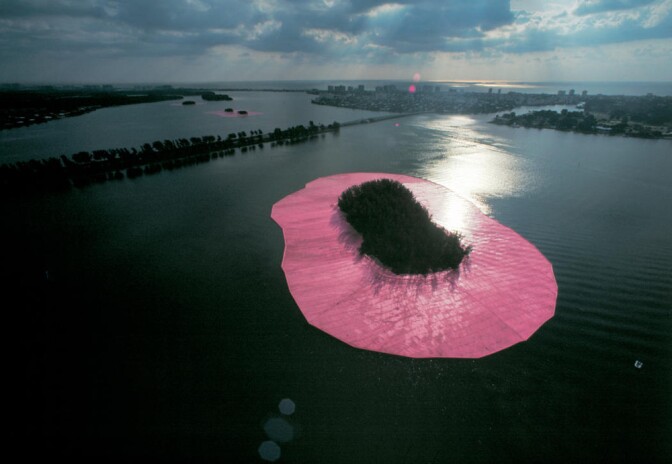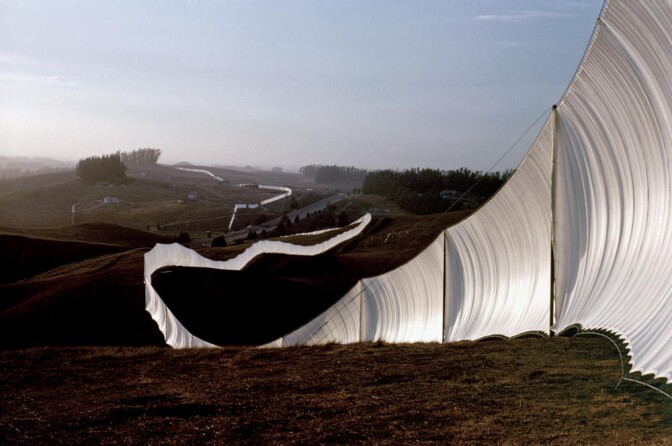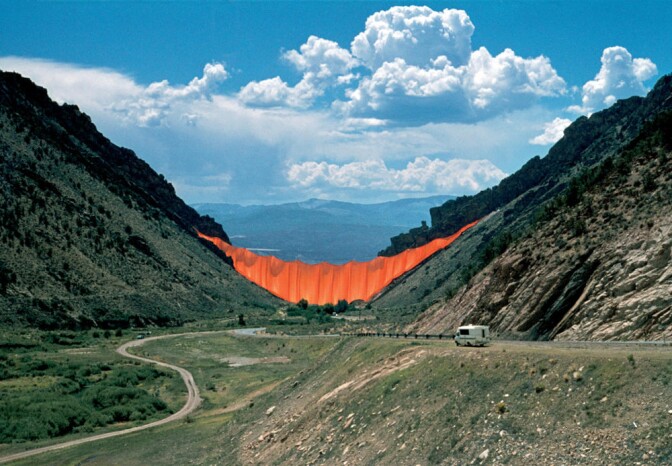Who Are the Intended Audiences of the Christo and Jean Claude Arts?

Art in the public realm challenges our agreement of engagement, interaction and memory, testing our conventionalities that the earth around u.s. is a wonderland of curiosity, discovery, and indefinite knowledge. Public artwork ofttimes endures acclaim and controversy in the communal and ecological fields of a mired social landscape. Afterward first meeting in 1958, Christo and Jeanne-Claude have pioneered a legacy of environmental art which has both encountered argue and expanded the role of art in public/private interactions to redefine our awareness and recognition of work in the social sphere.
Their nearly recent artwork, "The Floating Piers," was on view June 18 through July 3, transforming Italy's Lake Iseo with a modular floating dock system covered in a shimmering yellow fabric that turned shades of ruby-red and gold throughout the 16-mean solar day exhibition. Although free and open to the public, visitors were encouraged to check the weather forecast as rain and strong winds limited admission to the project, and tested the limits of public access due to natural elements -- a situation familiar to Christo and Jeanne-Claude and their history of environment projects.
The Umbrellas

Near the top of the northwestern corner of Los Angeles Canton where the Sierra Pelona, Tehachapi, and San Emigdio Mountains come across, is a high pass that links Southern
California to the Key Valley. Today it is popularly known as the Grapevine, a notorious road of traffic jams, overheated engines, and conditions closures. The highly traversed road is "i of the oldest continuously used trail and roadside rest stops in California," writes Bonnie Ketterl Kane in "A History of Gorman," every bit the Native Americans "would have stopped at that place when information technology was the Tataviam village of Kulshra'jek." one The mount meadows, streams, and panoramic valley views make information technology a pop stop for contemporary travelers, with California poppies, lupines, and other springtime wildflowers surfacing from the chaparral to encompass the hills in hues of blue and yellow when there is sufficient pelting.

At this site on October 9 1991, ecology artists Christo and Jeanne-Claude began the opening of iii,100 umbrellas in a sprawling temporary piece of work of public fine art intended to reflect similarities and differences in the ways of life and the use of the state of two inland valley locations beyond the Pacific Sea. Xviii miles along Interstate 5 between Gorman and the Grapevine blossomed with the daffodil yellow color of the umbrellas positioned on the backdrop of Tejon Ranch and private landowners. In synchronicity with the California site, 12 miles of cobalt bluish umbrellas were hoisted north of Tokyo, Japan effectually Route 349 and the Sato River, in the prefecture of Ibaraki. The bluish and yellow colors of the umbrellas were selected to emulate the landscape of Nippon's watery rice field geography, in contrast with the arid grassland of the California high desert.

More on Public Art
Each umbrella stood more 19 feet loftier, opened to a 28-foot diameter, and weighed 448 pounds generating an environmental exhibition that allowed the public to interact, touch, photo and experience the installations. "The Umbrellas" were designed to be enjoyed as free continuing modules, which Christo and Jeanne-Claude described as "a symbol for shelter, against both pelting and lord's day. It is an image that is easily understood, past any age, whatsoever state, any civilization, and this, for the past 4,800 years, since the umbrella shape was invented in Mesopotamia." ii The thousands of giant umbrellas placed alongside rivers, roads, and throughout the surrounding landscape created a temporary settlement for picnics, tourism, weddings and unexpectedly, the deaths of a tourist in California, and a worker in Japan.
Looking at topographic maps, and through the inspiration of walking, climbing, and surveying the land, the three,100 umbrellas used in the project were chosen as the artists laid out their design in response to the two landscapes. Jeanne-Claude had wanted to limit the number and maximum cost of the project to 3,000 umbrellas, however the terminal count of 3,100 umbrellas reflected the aesthetics of the environment rather than any financial concerns over the budget. The reported $26 million cost of the project was financed past The Umbrellas, Joint Project for Japan and U.S.A. Corporation with the artists as presidents. Post-obit a funding model that the artists utilise to finance their works, "The Umbrellas" used no public or corporate sponsorship, relying instead on the sale of Christo'south affiliate ephemera including studies, preparatory drawings, collages, scale models and original lithographs, which were sold to art collectors, museums and galleries.

Near artwork created in the public realm is discipline to all-encompassing budget accountability and transparency of public funding. Christo and Jeanne-Claude chose to retain control of their work by acting as their ain art dealers, operating a business model that doesn't accept grants or licensing deals to assure they retained artistic freedom and ultimately financial management over their work. Without publicly reported financials, the artists are often accused of conceptually inflating the costs of their projects including the $26 million toll tag attributed to "The Umbrellas." "We are borrowing a very complex public space for the work of art," Christo explained, "nosotros would have never talked to the Japanese farmers or the California land agencies, cowboys, rangers, if one of them was not absolutely sure that we would like to spend 26 million, not a conceptual 26 million to realize 'The Umbrellas.'"3
Working within the complex social context of public infinite requires an artist to consider the multiple perspectives and framework for display, participation and reception. In the 1979 catalog for "Earthworks: Land Reclamation as Sculpture," Robert Morris addressed the question, "what is public art?" asking, "If in that location is such a thing as public art, what then is private art? I recollect we would concur that any else it might or might not exist, the term public art has come to designate works not found in galleries or museums (which are public spaces), merely frequently in association with public buildings, and funded with public monies."four Working outside the institutional model of art production, Christo and Jeanne-Claude envisioned the project as requiring a participatory public appointment model rather than a public funding framework.
The Role of Art in Social Issues

Writing in "Mapping the Terrain: New Genre Public Art" (1996), artist Judith Baca questions the Tejon "Umbrellas" project and its public obligation with her critique in "Whose Monument Where? Public Art in a Many-Cultured Gild," which implores the problem of social date in the work on its intended public and site-specific purpose:
"When Christo, for case, looked for the beginning fourth dimension at El Tejon Laissez passer, he saw potential... The state became his canvas, a backdrop for his personal aesthetic… perhaps Native peoples could not call up of this area without recalling Fort Tejon, one of the starting time California Indian reservations established near this site in the Tehachapi Mountains, placed in that location to 'protect' Indians rounded upward from various neighboring areas, most of whose cultures take been entirely destroyed. In Christo'south and the Native visions we accept two different aesthetic sensibilities." 5
The political implications and consequences of public artworks in the public sphere are multifaceted and interconnected. If a customs-based work simultaneously displaces however integrates people into the procedure, its history and the lifespan of the work, is information technology socially responsible? Does this social engagement and participatory public interaction assimilate the diversity of perspective and personal stories into a narrative of institutional uniformity devoid of the nuances of a many-cultured guild now rendered greyness?

In the 1980s, Christo and Jeanne-Claude's "Surrounded Islands" swirled in public controversy "generating strong community opposition from environmental and civic organizations, boating and angling groups, and area residents." half dozen The public backfire reinforced Morris' question regarding "the supposition that at that place is something specially relevant to and open for the public in these projects, that they defend an aggressive, non-elitist, an even anti-museum stance, while at the same fourth dimension counting as avant-garde art." 7 The remarks point the curious involvement of the public in art -- every bit individuals, society, or regime finances and the ways in which public art tin can fracture space or the environs regardless of whether it'due south inside an institution or exterior of information technology.
Between Object and Speculation

Christo and Jeanne-Claude'south artworks are interventions into a given environment, and because the works are temporary, the art is given life not merely through the physical object, but the extensive visual documentation, and perhaps more importantly the memory and experiences of those who interacted with the piece of work. The bodily concrete objects they apply may be dismantled, recycled or repurposed for construction or ecological uses after their installation, yet, the works are intentionally conceived as the mental property of the people who experienced and interacted with the works. This speculative design, creation and retentiveness give the works a remarkable public sphere of life -- and perhaps spectacle -- in the maelstrom of social flux and change of time and imagination. Works such every bit "The Mastaba," a project for Abu Dhabi which was conceived in 1977 and nonetheless awaits its structure, exist in the public sphere as proposed drawings, feasibility studies and friendships with the emirate or agencies who interact with the projection in its initial entry equally conception and proposal in the public realm.
Art as Public Infinite

Every bit public art, Christo and Jeanne-Claude's works paved new footing for the concept and practice of art in the public sphere creating not only the attributed discovery and experience, just conversations around environmental sustainability, public accountability and legal liability concerns that publicly funded entities have wrangled with since art in social and public space left the building. "Running Fence," a structure of white nylon fabric hung from a steel cable is not but a large installation that augmented the topography of the land between Sonoma and Marin Counties, but it relayed the story of the people, places and events that occurred during the project's installation in 1976.
The projection consisted of the temporary utilise of the hills, the sky and the ocean, and 42 months of collaborative efforts, 18 public hearings, three sessions at the superior courts of California, and the drafting of an Environmental Impact Study – the first written report "e'er created for a work of fine art." viii Every bit such, Christo and Jeanne-Claude's works have continued to challenge and bulldoze the evolution of legal precedents for artistic interaction in the environment and public spaces. The impact of this contribution to the generation of dialogue, and eventual regulations around the controversial scope of public art in public space, has had numerous ramifications for the practise of fine art in relation to the institution and participation of art.
Controversial Participation

Conceived in 1992, "Over The River" proposes to install v.9 miles of silvery, luminous fabric panels to be suspended to a higher place the water forth a 42-mile stretch of the Arkansas River between Cañon Urban center and Salida in south-central Colorado. The viii distinct areas selected by Christo and Jeanne-Claude for aesthetic merits and technical capacity offering "2 different viewing experiences: one from the highway where the fabric will reflect the colors of the heaven, from the golden forenoon sunlight to the various hues of the sunset; the other from the h2o level, where rafters, kayakers and canoeists will be able to view the clouds, sky and mountain contours through the translucent fabric." 9 In a continued dispute over the temporary installation and its effect on the environmental of the land, a local Colorado environmental group Rags Over the Arkansas River (ROAR) opposed to "Over The River," filed lawsuits confronting the Colorado State Parks in country court and against the United States Federal Authorities, Agency of Land Management in U.S. Federal Court. "It's besides destructive to the people, to the surround and to the wildlife in Bighorn Sheep Canyon," said spokesperson Joan Anzelmo.x
With the project defenseless in the court of appeals and counter arguments on the utilize of public space and inevitable opposing viewpoints, "Over The River" continues to find grade in its prospective procedure. In addition, the offset Environmental Impact Statement for a work of art was completed for the initiative.xi The continued legal developments that Christo and Jeanne-Claude'south works unveil, expose more than but the material of the public sphere, as the process unwraps that "political institutions are collections of interrelated rules and routines that ascertain advisable activeness in terms of relations between roles and situations." 12 The contested works appoint discourse on civilisation and politics, request "how can the enthusiastic resources of foundation and corporate America be applied to meet the needs of beneficiaries without distorting culture in the process?"thirteen The struggle between ideology and the use of the environment and public space is fraught with differing opinions, perspectives, and implications in the institutional and diplomatic process.
It Cost How Much?

September 29, 2022 marked the 50th anniversary, and the signing engagement of President Lyndon B. Johnson'south National Foundation on the Arts and the Humanities Human activity of 1965. The act established the National Endowment for the Arts and the National Endowment for the Humanities, creating the partnership of land, local and other federal arts agencies along with the philanthropic sector to foster excellence in the arts, celebrate America'due south cultural heritage, support arts learning, and promote admission to the arts in every community. Unlike Christo and Jeanne-Claude's public financial "evasion" through fundraising as a private corporation, the NEA was notoriously subjected to the public money accountability question which led to the 1989 controversy over two federally funded projects: Andres Serrano's "Piss Christ" and Robert Mapplethorpe's "The Perfect Moment."
The Helms Subpoena required artists to promise they would non use government coin to create works of an "obscene" nature, compromising the NEA's budget while threatening its elimination. Although the NEA 4 -- Karen Finley, John Fleck, Holly Hughes, and Tim Miller -- successfully sued the NEA over the decency clause, because its vague restrictions suppressed spoken communication guaranteed past the 5th Subpoena, the accountability of public funding has connected to provoke controversy, civilisation wars and social conflicts of interest around public works of art.

In 2005, "The Gates" in New York Urban center's Central Park attracted an estimated 4 million visitors, and generated more than $250 meg in economic activity. The windblown saffron fabric panels which lined 23 miles of Primal Park walkways endured decades of opposition and controversy, requiring Christo and Jeanne-Claude to once again address public concerns on their proposal, ranging from an influx of large crowds to toxic plastic and special involvement funding. Eventually receiving a contract in 2003 from Mayor Michael R. Bloomberg, the project was so realized two years later. Bloomberg purchased two drawings from the couple, which in part helped secure the funding necessary for the installation, instigating public scrutiny and frustration. His interests as a patron and a public retainer increased the expectations for accountability to the customs, and fueled speculation on the bodily price and impact of the projection in the civic communal space of Central Park.
The vague and estimated calculation of the millions invested in "The Gates" activated the argument over questions and interest in budget line assay, and the quality of public bear upon versus a definable toll assessment in the value of the work. Would openly reported funding assist quantify an artworks success in concrete financial numbers or assist ascertain its quality? Lurking and vacillating below the surface of public projects is the dissonance between audiences and stakeholders, where funding and intentions can exist more subversive than what the activist and populist evaluation of public art lets on. In response to the claims of estimated funding, Christo has pointedly asked, "how do you calculate 26 years of meetings, negotiations, planning, design?"14
Weathering Controversy

The public is non the only critic of Christo and Jeanne-Claude'southward artwork equally several works have been subjected to a type of ecological censorship. Prior to the wind and lightening bravado over "The Umbrellas," which resulted in 2 deaths from each of the respective ecology weather condition in the USA-Japan project, "Valley Curtain," an orangish cocoon suspended at Rifle Gap between Grand Junction and Glenwood Springs in Colorado, began unraveling due to a gale forcefulness wind estimated in excess of threescore mph. But 28 hours after completion of the pall installation, the windy landscape dictated it necessary to outset the removal of the project. Christo explains, "The world tin live without 'Umbrellas,' without 'Valley Curtain' or 'Running Fence.' They have no other reason to be there except poetical creativity, total inventiveness. That freedom is the most important role of this project and this is why they cannot stay, because liberty is the enemy of possession and possession is equal to permanence." 15
Christo and Jeanne-Claude -- the latter, who passed away in 2009 -- have weathered public and ecological controversy surrounding their works since they began questioning the role of art in public/individual programming, and the meaning of ecology artwork. Their pursuit of works in the social landscape has challenged, defined and redefined understanding and acceptance of fine art in the public sphere. The works they have created provoke a sense of memory and participation. They have built spaces where art tin question our understanding of being -- hither and beyond. Lyrically, whether we choose to value "The Umbrellas," "The Gates," "Over the River," or "Valley Curtain" past the financial numbers, or as a reflection and contend of the social experience of art in the controversial agora of social territory, the respond, as Bob Dylan implores in his protest song, is blowin' in the air current.
Notes:
1 Ketterl Kane, Bonnie. (2002). "A History of Gorman."
ii Jeanne-Claude. (1998). "Most Mutual Errors."
3 Mantegna, Gianfranco. "Christo and Jeanne-Claude." (1995). Journal of Contemporary Art 7.two.
4 Morris, Robert. (1979). "Excavation: Land Reclamation as Sculpture."
v Baca, Judy. (1996). "Whose Monument Where? Public Art in a Many-Cultured Society." In Suzanne Lacy (Ed.) Mapping the Terrain: New Genre Public Art.
6 Bennetts, Leslie. (1982, December 28). "Christo will Wrap 11 Islands in Pink." The New York Times.
7 Morris, Robert. (1979). "Earthworks: Land Reclamation equally Sculpture."
viii Sonoma Canton Planning Section, Santa Rosa, California. (1975). "Final Environmental Bear on Written report: Running Fence."
nine Christo. (n.d.) "Over The River Projection for Arkansas River," State of Colorado FAQs.
ten Blevins, Jason. (2015, January 6). "Foes vow continued fight confronting Christo'south Over The River project." The Denver Post.
11 "U.South. Section of the Interior Bureau of Land Management." (2011). Environmental Touch Argument.
12 March, James 1000. & Olsen, Johan, P. (1989)." Rediscovering Institutions: The Organizational Basis of Politics." New York, NY: The Free Press.
13 Tepper, Steven J. (2012). "The Social Nature of Criminal offence and Public Protestation over Fine art and Culture." Grantmakers in the Arts Reader, Vol 23, No iii.
xiv McIntire, Mike. (2005, March 5). "Enough Most 'Gates' every bit Art; Let's Talk About That Price Tag." The New York Times.
15 Mantegna, Gianfranco. "Christo and Jeanne-Claude." (1995). Periodical of Gimmicky Art 7.2.
Top image: Christo and Jeanne-Claude looking for a possible site for The Mastaba, February 1982. | Photograph: Wolfgang Volz. © 1982 Christo.
Source: https://www.kcet.org/shows/artbound/blowin-in-the-wind-christo-and-jeanne-claudes-art-in-the-public-realm
0 Response to "Who Are the Intended Audiences of the Christo and Jean Claude Arts?"
Post a Comment